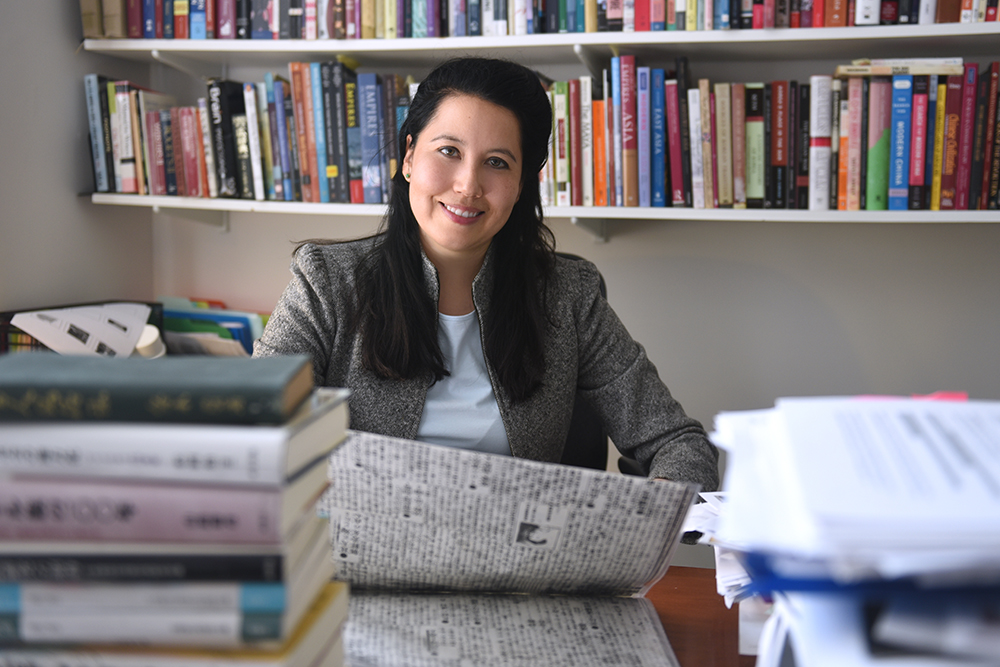Indigenous peoples often appear as caricatures in official histories and popular narratives of Japan’s 20th-century empire. A new book by assistant professor of history Kirsten Ziomek, PhD, paints a fuller picture of cultures that have long been marginalized.

Kirsten Ziomek, PhD, Assistant Professor of History
Assistant Professor Kirsten Ziomek, PhD, had just graduated from college when she set off to teach English in Japan. Her degree was in European history, but her stint abroad made her realize how little she knew about Japanese history.
Determined to change that, she pivoted to the study of Japanese history as a doctoral student. Much of Dr. Ziomek’s research now focuses on indigenous peoples and other colonial subjects in Japan’s 20th-century empire. Her book, “Lost Histories: Recovering the Lives of Japan’s Colonial Peoples,” was published this year by the Harvard University Asia Center.
As a mixed-race woman writing about the history of indigenous peoples, Dr. Ziomek understands that she must tread delicately.
“There’s a lot of debate within indigenous studies about who can write that history—if you are trying to superimpose your Western point of view on their history and corrupting it,” Dr. Ziomek says. “I have realized that what matters is that people attempt to write these histories, because if we don’t, then we perpetuate a lopsided narrative.”
She focuses on unearthing the untold stories of the colonial subjects, exploring the gray areas between official history and popular narratives. Lessons about the relationships between colonizers and the colonized in that corner of Asia can often apply to similar narratives across the globe, she says.
“It’s not just a matter of discounting everything the Japanese have written and elevating everything that these indigenous sources reveal, but trying to find a way to use all the resources you can find and weave it all together to form a more nuanced picture,” she says.
Take Yayutz Bleyh, a Taiwanese indigenous Atayal woman. While popular narrative might suggest that Bleyh, who died in the 1930s, had little opportunity for a career, records prove she was a high-ranking colonial administrator married to a Japanese man.
Dr. Ziomek met Yayutz Bleyh’s grandson, who painted a compelling portrait of his grandmother as a woman who enjoyed high status.
“There aren’t just two versions of history, the colonizer and the colonized. The actual picture is a little murky on both sides,” Dr. Ziomek says.
As the Bleyh example demonstrates, some of Dr. Ziomek’s research refutes narratives about the universal victimization of indigenous peoples that saw them as acted upon and not actors themselves. The far-flung empire’s administration differed according to locale, and in some areas the Japanese relied on local leaders for their influence.
Dr. Ziomek’s research also showed that Japanese programs to portray indigenous peoples as “savages” were often a charade. The Japanese routinely presented “village displays,” featuring colonial subjects in living exhibits, at international exhibitions. A display about the Ainu people of Hokkaido at the 1904 Louisiana Purchase Exposition in St. Louis, Missouri, included an Ainu named Pete Gorō. Dr. Ziomek spoke with his granddaughter. “She talked about how he really wanted to go to America because he saw it as an opportunity, and when the exhibition was over he wanted to stay longer,” Dr. Ziomek says. She found photo albums from his time in America showing his travels.
“It really opens up this new way of looking and viewing his experience,” Dr. Ziomek says.
Her work—which makes extensive use of archival photographs—brings new focus to cultures that have long been marginalized. It also presents a much more complex picture of this time in East Asian history, countering conventional views put forward by both the colonizers and their critics.
For further information, please contact:
Todd Wilson
Strategic Communications Director
p – 516.237.8634
e – twilson@adelphi.edu